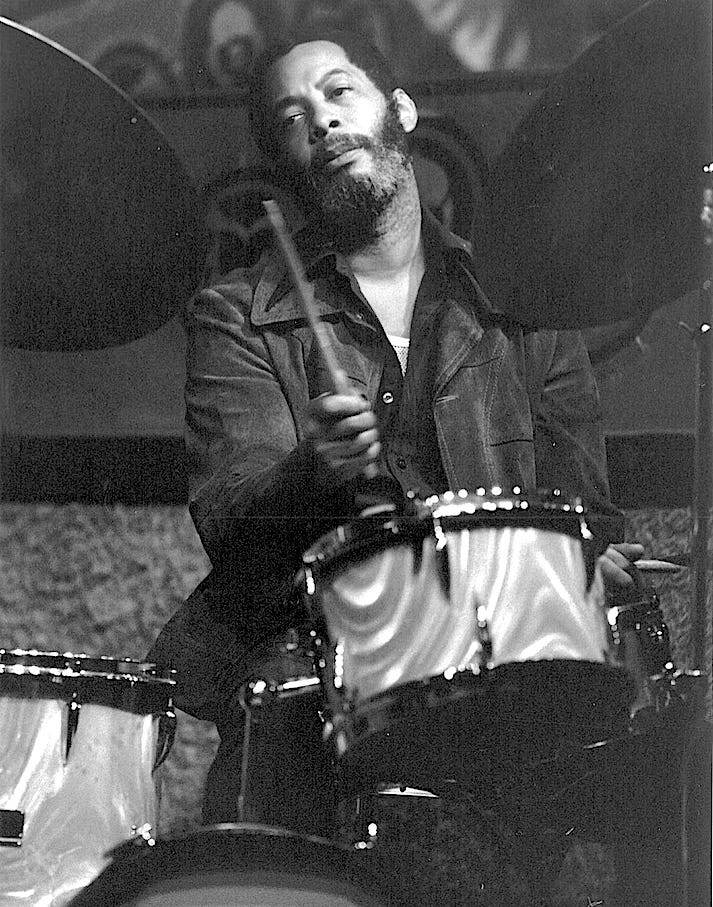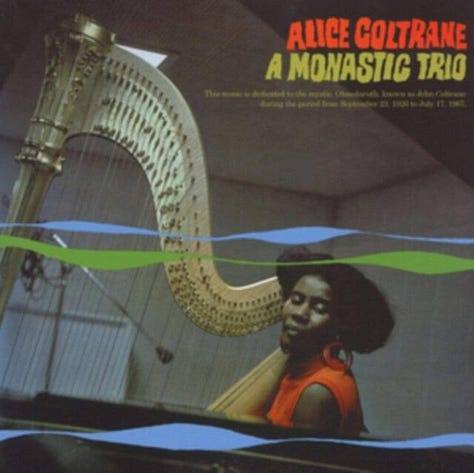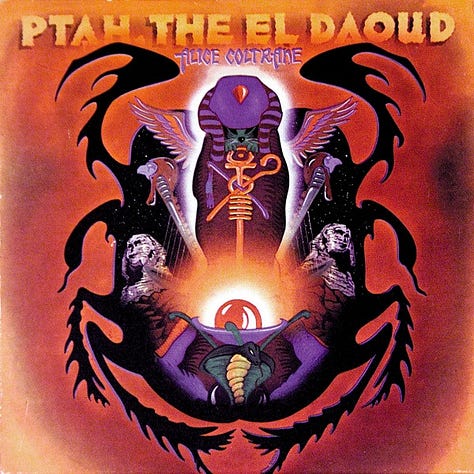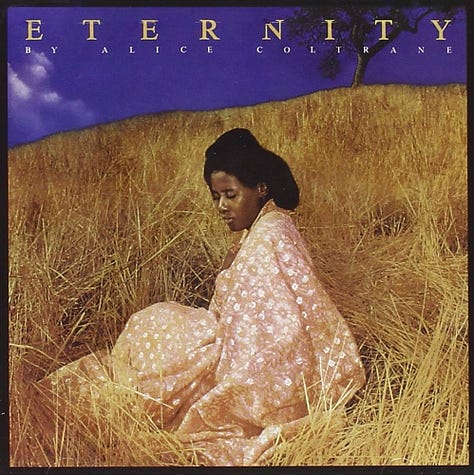Alice Coltrane’s Transfiguration (Warner Bros, 1978) is a stunning live date with some incredible Roy Haynes. Throughout, Haynes swings gracefully and dashes around his multi-tom kit, lending fiery support to Alice’s universal vision and freewheeling melodies. “Leo” is my go-to, in two parts and 36 minutes long. If you have less time, check out “Affinity”, just 11 hypnotic minutes.
Listening to Transfiguration pushed me to dig a little deeper with Alice Coltrane, one of the most important voices of our era. I lighted on two of her early Impulse records, A Monastic Trio (1968) and Ptah The El Daoud (1970), both of which feature drummer Ben Riley.

Born in 1933 in Savannah, GA, Ben Riley arrived in Harlem as a toddler and played on Sonny Rollins’s The Bridge (RCA, 1962) before he was thirty. From the Eighties onward, Ben was often seen with pianist Kenny Barron, one of our most treasured artists. Today, Riley’s probably best-remembered for being a member of Thelonious Monk’s quartet from 1963 to 1968, appearing on some classic albums from Monk’s tenure with Columbia Records, including It’s Monk’s Time (1964), Straight No Chaser (1967, one of my very favorites) and Underground (1968).
Perhaps the essence of Ben Riley’s music was his unique cymbal beat. Like all the great jazz drummers, Riley’s beat, which swung mightily, was so distinct and personal that it became his giveaway. At every tempo, in every setting, Riley’s cymbal playing was precisely articulated, yet his beat skipped and danced playfully, often with a gentle emphasis on 2 and 4, the backbeat. As light and graceful as it was driving and intense, Ben Riley’s cymbal beat sparkled while the rest of his limbs bubbled, a subtle one-man percussion section who inspired every soloist he accompanied.
Riley seemed to prefer the high-pitched, Kenny Clarke/Connie Kay cymbal sound early on; later, the low-pitched Art Blakey/Jimmy Cobb cymbal sound came to the fore. When I saw him play around the turn of the century, he had multiple ride cymbals and a China cymbal, and switched between them frequently, something I’d never heard him do on records.
Like Kenny Clarke (born 1914), Connie Kay (born 1927), Jimmy Cobb (born 1929), Mel Lewis (born 1929), and Albert “Tootie” Heath (born 1935), at first listen, it might seem as if Ben Riley is “just playing time on the cymbal.” This is a misunderstanding. Listen closer, and there’s a world of coughs, sighs, hand-claps, and thunderstorms played by the snare drum, hi-hat, and bass drum just below the surface, stuff you can’t really notate, things you have to see someone play to really get.
Moreover, to play cymbal-centered jazz drums on the highest level requires an abundance of technique and musicianship! That’s not “just playing time”. Swinging a band of idiosyncratic virtuosos with a cymbal, as Ben Riley did, is a pinnacle of drum artistry and technique. In the end, Ben Riley is one of the greatest ever, period.



Ben Riley died in 2017, at the age of 84. I’ve been making notes for an essay overview of his entire career, but for now, let’s focus on a few choice tracks of Ben with Alice Coltrane. It’s timeless and timely music, just what the season calls for.
“The Sun” from A Monastic Trio (Impulse, 1968). John Coltrane’s words cast a spell, and call out to the best of ourselves in a timeless wish for peace, love, and perfection. While Alice and bassist Jimmy Garrison state the theme, Ben Riley sings his song on the ride cymbal, shimmering, simple, spare, and powerfully emotive, perfectly capturing the song’s spirit.
“Ptah The El Daoud” from Ptah The El Daoud (Impulse, 1970). Performed by an all-star quintet of Alice Coltrane, tenor saxophonists Joe Henderson and Pharoah Sanders, plus bassist Ron Carter and Riley, “Ptah The El Daoud”, in tribute to an Egyptian deity, is otherworldly and down-to-earth. In 1970, Ron Carter and Ben Riley already had a long history, going back to Johnny Griffin’s band in 1961. What a beat they get on this track! I notice how easily Riley supports the diverse soloists, (Henderson, Sanders, and Coltrane) without altering his fundamental style. Love his solo too; his Max Roach-derived bebop melodies are right at home in Alice Coltrane’s universe.
“Turiyah and Ramakrishnah” from Ptah The El Daoud (Impulse, 1970). The Kenny Clarke line of drummers could convey maximum meaning with the tiniest gesture, and Riley always named Kenny Clarke as his biggest inspiration. Dig Riley’s beautiful, detailed brush playing, conveying all the emotion the piece needs.
“Blue Nile” from Ptah The El Daoud (Impulse, 1970). “Blue Nile” might be the best-known cut from this album, with Carter’s funky bass line, Alice’s harp, and the evocative two-flute melody not easily forgotten. Maybe the setting’s a little different than what he’s known for, but Ben Riley doesn’t alter his approach, and he’s obviously at ease. In a sense, this is truly free jazz drumming— Riley is free to play with anyone he chooses, because he’ll always be himself, selflessly committed to the music. Playing clear, graceful, and open jazz drums, Riley lets Henderson, Sanders, Coltrane, and Carter stay home or go out, as they feel. As great as everyone is here, it’s Ben Riley who ties this track together.
“Los Caballos” from Eternity (Warner Bros, 1975) Conguero Armando Peraza leads a group of percussionists who sound great, but are mixed so high as to almost drown out Riley and bassist Charlie Haden. But we can make out enough, and it’s a gas to hear Ben and Charlie get funky and aggressive with Alice’s organ. As the tempo increases, Riley’s ride cymbal becomes more audible, while Alice and Charlie pull Ben almost to Jack DeJohnette territory. After the percussion breakdown, Charlie returns to the vamp, and we get a few seconds of unadulterated Ben Riley backbeat. Mix notes aside, “Los Caballos” is a lot of fun.
BONUS TRACK:
Abdullah Ibrahim, “Water From An Ancient Well” from Water From An Ancient Well (Black Hawk, 1985). Riley, with brushes all the way, shows us his take on the gospel backbeat, keeping the song moving and the energy bubbling. It’s so casual-sounding and easygoing that we can overlook Riley’s deep understanding of the soloists, the backbeat, and the meaning of Ibrahim’s music. Everyone is inspired here, but without Riley’s clean, simple, low-key propulsion, the band couldn’t get off the ground. (Shoutout to Ethan Iverson and bassist Simón Willson for this track, one of our jams on our recent Midwest run of dates.)
In the USA, we celebrate Thanksgiving this Thursday, and despite everything, there’s so much to be thankful for. Music and community are sources of strength, always and forever. With Alice Coltrane and Ben Riley, we’ve got what we need.




Mr. Riley’s use of different cymbals within his accompaniment of the soloist is very apparent on Kenny Barron’s LIVE AT BRADLEY’S. Brilliant! Happy Thanksgiving, Vinnie!
Nicely written, Vinnie – the first class I took in grad school was taught by Bill Lowe (trombone and tuba), the draw for me being the class would go to NYC once a month to see & hear live music. as it turned out, two of the three shows we saw featured Bill Barron (the head of the Music Dept. at Wesleyan U) with brother Kenny, Ben Riley, and Cecil McBee (once) and Buster Williams (the other show). Ben was great fun to listen to; he would lock in to whatever Kenny was playing and didn't every let go! Great brushes player as well. Thanks for the reminder of his positive musicianship!